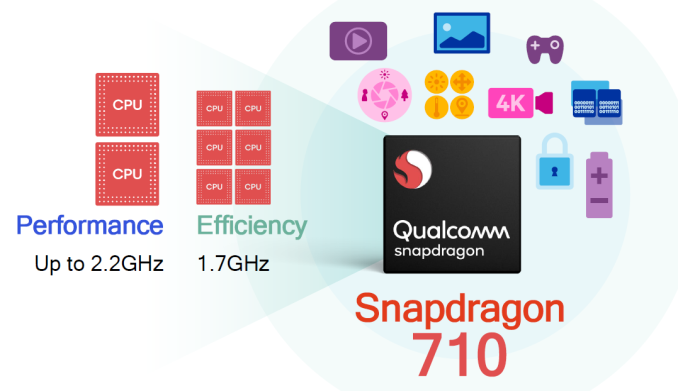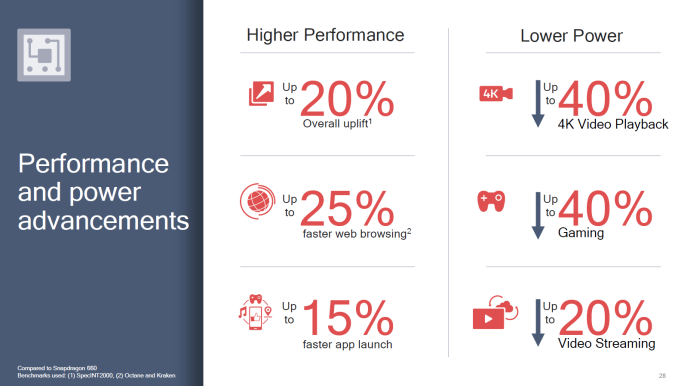Qualcomm Announces Snapdragon 710 Platform
by Andrei Frumusanu on May 23, 2018 10:00 PM EST
Today Qualcomm announces a new entry to the Snapdragon lineup with the first 700-series SoC platform. The Snapdragon 710 is a direct successor to the Snapdragon 660 but comes with a new branding more worthy of the increased performance characteristics of the SoC. The higher-end 600 series SoCs such as the Snapdragon 650 and 660 were among the first non-flagship SoCs that used big CPU cores, which brought a significant jump in terms of performance to the mid-range.
While we haven’t seen that many design wins with the Snapdragon 650/660’s, they are increasingly becoming popular among Chinese vendors for example. The Snapdragon 710 fixes this branding issue of having quite capable SoCs with large CPU cores grouped together as the 700 series, while the lower tiered SoCs such as the Snapdragon 625 or 635 remain in the 600 series .
| Qualcomm Snapdragon Upper Mid-Range SoCs | ||
| SoC | Snapdragon 710 | Snapdragon 660 |
| CPU | 2x Kryo 360 (CA75) @ 2.2GHz 6x Kryo 360 (CA55) @ 1.7GHz |
4x Kryo 260 (CA73) @ 2.2GHz 4x Kryo 260 (CA53) @ 1.8GHz |
| GPU | Adreno 616 | Adreno 512 |
| DSP | Hexagon 685 | Hexagon 680 |
| ISP/ Camera |
Spectra 250 ISP 32MP single / 20MP dual |
Spectra 160 ISP 24MP |
| Memory | 2x 16-bit @ 1866MHz LPDDR4X 14.9GB/s 1MB? system cache |
2x 16-bit @ 1866MHz LPDDR4 14.9GB/s |
| Integrated Modem | Snapdragon X15 LTE (Category 15/13) DL = 800Mbps 3x20MHz CA, 256-QAM UL = 150Mbps 2x20MHz CA, 64-QAM |
Snapdragon X12 LTE (Category 12/13) DL = 600Mbps 3x20MHz CA, 256-QAM UL = 150Mbps 2x20MHz CA, 64-QAM |
| Encode/ Decode |
2160p30, 1080p120 H.264 & H.265 10-bit HDR pipelines |
2160p30, 1080p120 H.264 & H.265 |
| Mfc. Process | 10nm LPP | 14nm LPP |
The big IP blocks found on the Snapdragon 710 are very much derivatives of what’s found on the flagship Snapdragon 845. On the CPU side we see the same 2.2GHz maximum clock on the big cores, but the Kryo 360 Cortex-A75 based CPUs are microarchitectural upgrade over last year’s A73 based Kryo 260. The little cores are also based on the newer Cortex-A55’s and are clocked at up to 1.7GHz. The performance improvements are quoted as an overall 20% uplift in SPECint2000 and 25% faster performance in Octane and Kraken versus the SD660.
The SoC now also uses the new system cache first introduced in the Snapdragon 845 – although I’m expecting a smaller, yet unconfirmed 1MB size in the SD710.
GPU-wise, this is also Qualcomm’s first mid-range SoC sporting the new 600 series Adreno. As usual we don’t have too much information about the Adreno 616 other than an expected frequency of around 750MHz. The performance benefits on the GPU are quoted at up to 35% higher performance versus the Adreno 512 in the SD660.
In terms of connectivity the new SoC implements an X15 modem which is capable of UE Category 15 in the downstream with up to 800Mbps in 3x carrier aggregation and up to UE Category 7 in the upload with up to 2x CA. The new chipset now also offers 2x2 802.11ac digital backend for WiFi – however it’ll still need an external discrete analog RF frontend.
Where the Snapdragon 710 is claimed to shine though is power efficiency. The chipset is manufactured on the Samsung's leading edge 10nm LPP node – same as the Snapdragon 845. The fact that Qualcomm is targeting a leading edge node might be a sign of the where 700-series is headed and what it’s aiming for.
It’s not only on the CPU and on the manufacturing node where the 710 borrows features from the 845- the Hexagon DSP is of the same generation and the Spectra 250 ISP also inherits most of the new features found in the flagship SoC which should greatly improve image processing for mid-range devices. The camera and display pipelines are fully 10-bit capable so it can handle HDR capture and display.
Overall the Snapdragon 710 really does seem like a toned down 845 variant which actually balances out some important aspects. It’s especially good to see the mid-range being pushed into the 10nm manufacturing node as that will give a generation power efficiency jump for the relevant devices.
The Snapdragon 710 platform is available today and Qualcomm expects consumer devices to be launched in this second quarter – meaning we’ll likely to see some vendor announcements around Computex.












42 Comments
View All Comments
prussian - Wednesday, May 23, 2018 - link
Looking at the pic CPU cores appear to be 2+6 rather than 4+4 configuration.WPX00 - Wednesday, May 23, 2018 - link
Previous rumors pegged it as a 2x6 config as well. The Qualcomm website doesn't mention it though.Andrei Frumusanu - Thursday, May 24, 2018 - link
I was briefed on 4+4 configuration by Qualcomm - the slide came from a later update and I hadn't noticed. Updated the spec table.Wardrive86 - Wednesday, May 23, 2018 - link
Isn't Kryo 260 Gold based on Cortex a73?mczak - Thursday, May 24, 2018 - link
Yes indeed it's based on a73, not a72.Well actually you can as well say it's based on a53... Because QC simply says "8x Kryo 260" - so it refers to both the little a53 as well as the big a73 cores - talk about nonsense naming...
Although sometimes they also refer to "kryo cpu" as a whole which would make a bit more sense...
Plumplum - Thursday, May 24, 2018 - link
Memory is probably 2x16bits on S660...you can see it on AnTuTu Memory test an detailed geekbench scores that S660 and S835 dont use the same 2x32bits 1866Mhz memoryWardrive86 - Thursday, May 24, 2018 - link
660 does have dual 16 bit memory channelsWardrive86 - Thursday, May 24, 2018 - link
I agree it isn't the best naming scheme. It is pretty easy to determine between the Gold and Silver monikers, but they do often refer to all of them as just Kryo xxxPlumplum - Thursday, May 24, 2018 - link
In my opinion, Kryo is only a name.You can take all the detailed singlecore's score in geekbench of P60 and S660, divide them by the frequencies and you will get...the same results as memories are close : 2x16bits 1800Mhz and 1866Mhz
You can do the same with 835...only memory results are differents due to 2x32bits higher bandwidth!
Kryo 260 is nothing more than 4A73+4A53, with 2x16bits RAM management.
Kryo 280 is nothing more than 4A73+4A53, with 2x32bits RAM
But people think : "waouw, it's Kryo custom cores, it's better than standard Arm", it isn't
Wardrive86 - Thursday, May 24, 2018 - link
Qualcomm does have some scheduler "secret sauce" that does wonders even if the cores are vanilla..SD625 through their high end SoCs are proof of this. They also have amazing GPU drivers now, it was a different case in the past but now I don't know of better GPU drivers in the mobile space. Qualcomm currently also has the best effciency in the mid and high end. Maybe alot of it is in the "uncore" maybe not. It has put them on top and I'm sure a LOT of customization went into those aspects alone, so to me that is Kryo..I.e...better than stock ARM